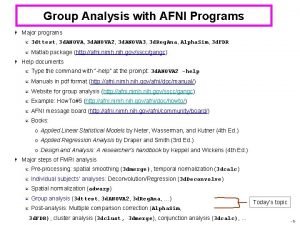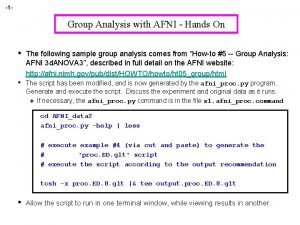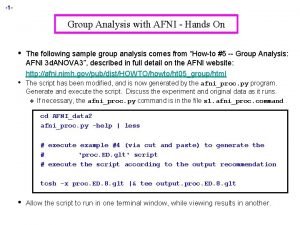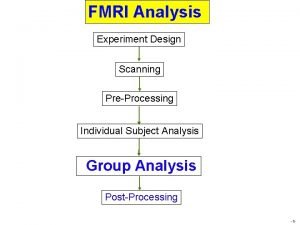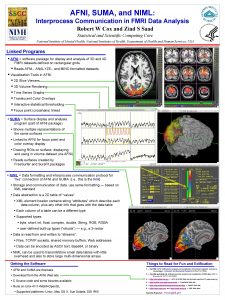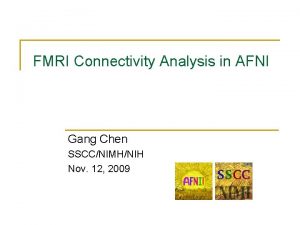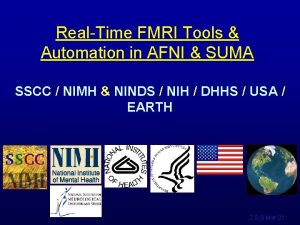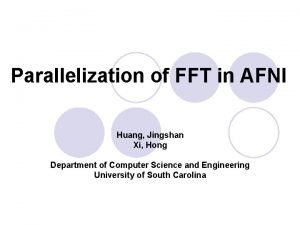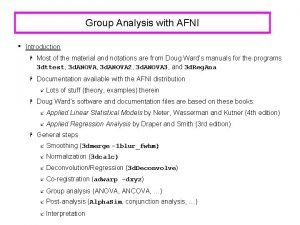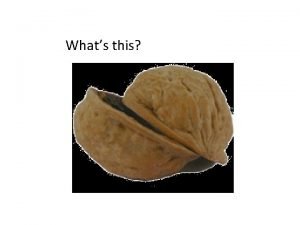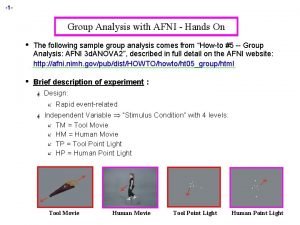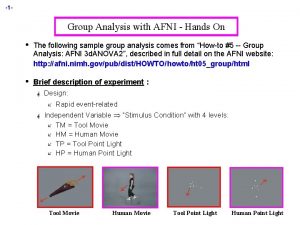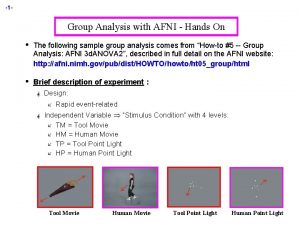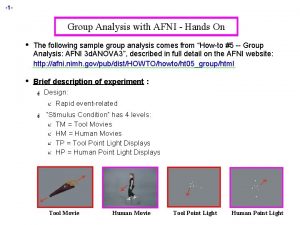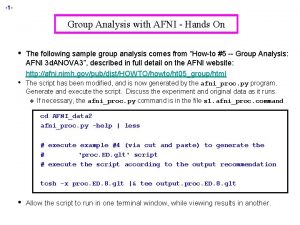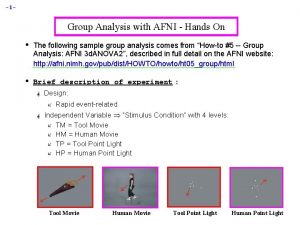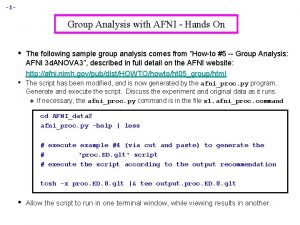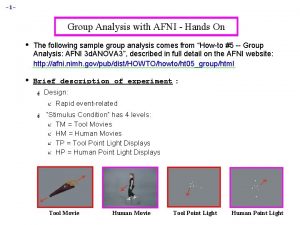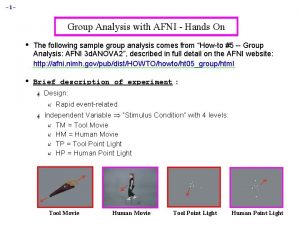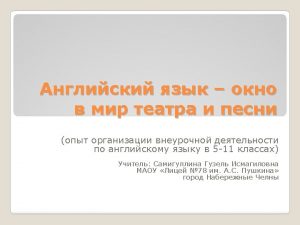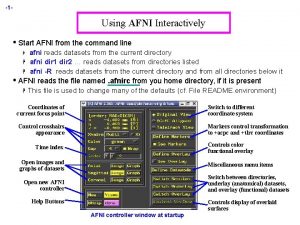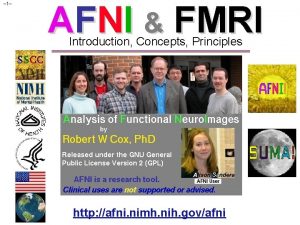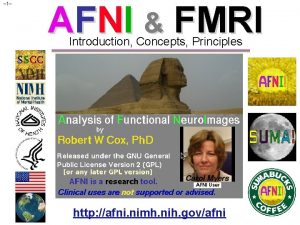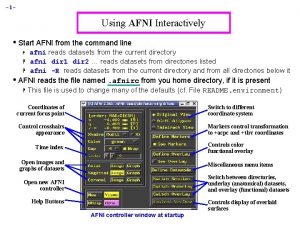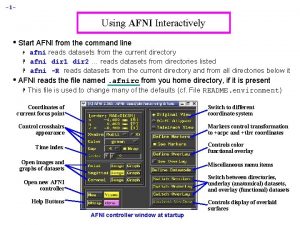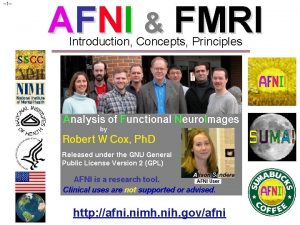1 Group Analysis with AFNI Hands On The













































- Slides: 45

-1 - Group Analysis with AFNI - Hands On • • The following sample group analysis comes from “How-to #5 -- Group Analysis: AFNI 3 d. ANOVA 3”, described in full detail on the AFNI website: http: //afni. nimh. gov/pub/dist/HOWTO/howto/ht 05_group/html The script has been modified, and is now generated by the afni_proc. py program. Generate and execute the script. Discuss the experiment and original data as it runs. v If necessary, the afni_proc. py command is in the file s 1. afni_proc. command. cd AFNI_data 2 afni_proc. py -help | less # execute example #4 (via cut and paste) to generate the # 'proc. ED. glt' script # execute the script according to the output recommendation tcsh -x proc. ED. 8. glt |& tee output. proc. ED. 8. glt • Allow the script to run in one terminal window, while viewing results in another.

-2 - • Brief description of experiment : v Design: Rapid event-related Ø v stimulus or fixation presented randomly on a 1 -second time grid There are 4 stimulus types: Tool Movie v Human Movie Tool Point Light Human Point Light Data Collected: Ø 1 Anatomical (SPGR) dataset for each subject • 124 sagittal slices Ø 10 Time Series (EPI) datasets for each subject • 23 axial slices x 138 volumes = 3174 slices per run • TR = 2 sec; voxel dimensions = 3. 75 x 5 mm Ø Sample size, n=7 (subjects ED, EE, EF, FH, FK, FL, FN)

-3 - • Analysis Steps: v Part I: Process data for each subject Ø Pre-process subjects’ data many steps involved here… Ø Run deconvolution analysis on each subject’s dataset --- 3 d. Deconvolve v Part II: Run group analysis Ø warp results to standard space Ø 3 -way Analysis of Variance (ANOVA) --- 3 d. ANOVA 3 • • Object Type (2) x Animation Type (2) x Subjects (7) = 3 -way ANOVA Class work for Part I: v view the original data by running afni from the ED directory v then view output data from the ED. 8. glt. results directory cd ED afni &

-4 - • PART I Process Data for each Subject First: Hands-on example: Subject ED v We will begin with ED’s anat dataset and 10 time-series (3 D+time) datasets: EDspgr+orig, EDspgr+tlrc, ED_r 01+orig, ED_r 02+orig … ED_r 10+orig v Ø Below is ED’s ED_r 01+orig (3 D+time) dataset. Notice the first two time points of the time series have relatively high intensities*. We will need to remove them later: Timepoints 0 and 1 have high intensity values Images obtained during the first 4 -6 seconds of scanning will have much larger intensities than images in the rest of the timeseries, when magnetization (and therefore intensity) has decreased to its steady state value

-5 - • Pre-processing is done by the proc. ED. 8. glt script within the directory, AFNI_data 2/ED. 8. glt. results. v go to the ED. 8. glt. results directory to start viewing the results v also, open the proc. ED. 8. glt script in an editor (such as gedit), and follow the script while viewing the results v starting from the ED directory (from the previous slides)… cd. . gedit proc. ED. 8. glt & cd ED. 8. glt. results ls afni & v note that in the script, the count command is used to set the $runs variable as a list of run indices: • set runs = ( `count -digits 2 1 10` ) becomes: • set runs = ( 01 02 03 04 05 06 07 08 09 10 ) v And so: • foreach run ( $runs ) becomes: • foreach run ( 01 02 03 04 05 06 07 08 09 10 )

-6 - • STEP 0 (tcat): Apply 3 d. Tcat to copy datasets into the results directory, while removing the first 2 TRs from each run. v The first 2 TRs from each run occurred before the scanner reached a steady state. 3 d. Tcat -prefix $output_dir/pb 00. $subj. r 01. tcat ED/ED_r 01+orig'[2. . $]' v v v The output datasets are placed into $output_dir, which is the results directory. Using sub-brick selector '[2. . $]' sub-bricks 0 and 1 will be skipped. Ø The '$' character denotes the last sub-brick. Ø The single quotes prevent the shell from interpreting the '[' and '$' characters. The output dataset name format is: pb 00. $subj. r 01. tcat (. HEAD /. BRICK) Ø Ø pb 00 $subj r 01 tcat : process block 00 : the subject ID (ED. 8. glt, in this case) : EPI data from run 1 : the name of this processing block (according to afni_proc. py) (other block names are tshift, volreg, blur, mask, scale, regress)

-7 - • STEP 1 (tshift): Check for possible “outliers” in each of the 10 time series datasets using 3 d. Toutcount. Then perform temporal alignment using 3 d. Tshift. v v An outlier is usually seen as an isolated spike in the data, which may be due to a number of factors, such as subject head motion or scanner irregularities. The outlier is not a true signal that results from presentation of a stimulus event, but rather, an artifact from something else -- it is noise. foreach run (01 02 03 04 05 06 07 08 09 10) 3 d. Toutcount -automask pb 00. $subj. r$run. tcat+orig > outcount_r$run. 1 D end v How does this program work? For each time series, the trend and Mean Absolute Deviation are calculated. Points far away from the trend are considered outliers. Ø "far away" is defined as at least 5. 43*MAD (for a time series of 136 TRs) • see 3 d. Toutcount -help for specifics Ø -automask: do the outlier check only on voxels within the brain and ignore background voxels (which are detected by the program because of their smaller intensity values) Ø > : redirect output to the text file outcount_r 01. 1 D (for example), instead of sending it to the terminal window.

-8 - v v Subject ED’s outlier files: outcount_r 01. 1 D outcount_r 02. 1 D … outcount_r 10. 1 D Note: “ 1 D” is used to identify a numerical text file. In this case, each file consists a column of 136 numbers (b/c of 136 time points). Use AFNI 1 dplot to display any one of ED’s outlier files. For example: 1 dplot outcount_r 04. 1 D number of ‘outlier’ voxels, per TR Outliers? Inspect the data. High intensity values in the beginning are usually due to scanner attempting to reach steady state. time

-9 v v v in afni, view run 04, time points 117, 118 and 119 (0 -based) while it appears that something happened at time point 118 (such as a swallow, or similar movement), it may not be enough to worry about if there had been a more significant problem, and if it could not be fixed by 3 dvolreg, then it might be good to censor this time point via the -censor option in 3 d. Deconvolve internal movement can be seen in this area, using afni

-10 - • Next, perform temporal alignment using 3 d. Tshift. v v Slices were acquired in an interleaved manner (slice 0, 2, 4, …, 1, 3, 5, …). Interpolate each voxel's time series onto a new time grid, as if each entire volume had been acquired at the beginning of the TR. Ø For example, slice #0 was acquired at times t = 0, 2, 4, etc. , in seconds. Slice #1 was acquired at times t = 1. 043, 3. 043, 5. 043, etc. Ø After applying 3 d. Tshift, all slices will have offset times of t = 0, 2, 4, etc. 3 d. Tshift -tzero 0 -quintic -prefix pb 01. $subj. r$run. tshift pb 00. $subj. r$run. tcat+orig Ø -tzero 0 Ø -quintic : the offset for each slice is set to the beginning of the TR : interpolate using a 5 th degree polynomial

-11 v Subject ED’s newly created time shifted datasets: pb 01. ED. 8. glt. r 01. tshift+orig (. HEAD/. BRIK). . . pb 01. ED. 8. glt. r 10. tshift+orig (. HEAD/. BRIK) v Below is run 01 of ED’s time shifted dataset. 4 2 0 Slice acquisition now in synchrony with beginning of TR

-12 - • STEP 2: Register the volumes in each 3 D+time dataset using AFNI program 3 dvolreg. Register all volumes to the third of the session. foreach run ( $runs ) 3 dvolreg -verbose -zpad 1 -base pb 01. $subj. r 01. tshift+orig'[2]' -1 Dfile dfile. r$run. 1 D -prefix pb 02. $subj. r$run. volreg pb 01. $subj. r$run. tshift+orig end cat dfile. r? ? . 1 D > dfile. rall. 1 D Ø Ø Ø Ø -verbose: prints out progress report onto screen -zpad : add one temporary zero slice on either end of volume -base : align to third volume, since anatomy was scanned before EPI -1 Dfile : save motion parameters for each run (roll, pitch, yaw, d. S, d. L, d. P) into a file containing 6 ASCII formatted columns -prefix : output dataset names reflect processing block 2, volreg input datasets are from processing block 1, tshift concatenate the registration parameters from all 10 runs into one file

-13 - v Subject ED’s 10 newly created volume registered datasets: pb 02. ED. 8. glt. r 01. volreg+orig (. HEAD/. BRIK). . . pb 02. ED. 8. glt. r 10. volreg+orig (. HEAD/. BRIK) v Below is run 01 of ED’s volume registered datasets.

-14 - v view the registration parameters in the text file, dfile. rall. 1 D Ø this is the concatenation of the registration files for all 10 runs 1 dplot -volreg dfile. rall. 1 D v very little movement is apparent - a good subject

-15 - • STEP 3: Apply a Gaussian filter to spatially blur the volumes using program 3 dmerge. v v v result is somewhat cleaner, more contiguous activation blobs also helps account for subject variability when warping to standard space spatial blurring will be done on ED’s time shifted, volume registered datasets foreach run ( $runs ) 3 dmerge -1 blur_fwhm 4 -doall -prefix pb 03. $subj. r$run. blur pb 02. $subj. r$run. volreg+orig end Ø -1 blur_fwhm 4: use a full width half max of 4 mm for the filter size Ø -doall : apply the editing option (in this case the Gaussian filter) to all sub-bricks in each dataset

-16 - v results from 3 dmerge: pb 02. ED. 8. glt. r 01. volreg+orig pb 03. ED. 8. glt. r 01. blur+orig Before blurring After blurring

-17 - • STEP 3. 5 (unnumbered block): creating a union mask v v v use 3 d. Automask to create a 'brain' mask for each run create a mask which is the union of the run masks this mask can be applied in various ways: Ø during the scaling operation Ø in 3 d. Deconvolve (so that time is not wasted on background voxels) Ø to group data, in standard space • may want to use the intersection of all subject masks foreach run ( $runs ) 3 d. Automask -dilate 1 -prefix rm. mask_r$run pb 03. $subj. r$run. blur+orig end Ø -dilate 1 : dilate the mask by one voxel

-18 v next, take the union of the run masks Ø Ø the mask datasets have values of 0 and 1 can take union by computing the mean and comparing to 0. 0 • other methods exist, but this is done in just two simple commands 3 d. Mean -datum short -prefix rm. mean rm. mask*. HEAD 3 dcalc -a rm. mean+orig -expr 'ispositive(a-0)' -prefix full_mask. $subj Ø -datum short : force full_mask to be of type short Ø rm. * files Ø -a rm. mean+orig : specify the dataset used for any 'a' in '-expr' Ø -expr 'ispositive(a-0)': evaluates to 1 whenever 'a' is positive • note that the comparison to 0 can be changed ü 0. 99 would create an intersection mask ü 0. 49 would mean at least half of the masks are set : these files will be removed later in the script

-19 v v so the result is dataset, full_mask. ED. 8. glt+orig view this in afni Ø load pb 03. ED. 8. glt. r 01. blur+orig as the underlay Ø load the mask dataset as the overlay Ø set the color overlay opacity to 5 • allows the underlay to show through the overlay color overlay opacity arrows

-20 - • STEP 4: Scaling the Data - as percent of the mean v for each run Ø for each voxel • compute the mean value of the time series • scale the time series so that the new mean is 100 v scaling becomes an important issue when comparing data across subjects v Ø using only one scanner, shimming affects the magnetization differently for each subject (and therefore affects the data differently for each subject) Ø different scanners might produce vastly different EPI signal values without scaling, the magnitude of the beta weights may have meaning only when compared with other beta weights in the dataset Ø v What does a beta weight of 4. 7 mean? Basically nothing, by itself. • It is a small response, if many voxels have responses in the hundreds. • It is a large response, if it is a percentage of the mean. by converting to percent change, we can compare the activation calibrated with the relative change of signal, instead of the arbitrary baseline of FMRI signal

-21 v For example: Subject 1 - signal in hippocampus has a mean of 1000, and goes from a baseline of 990 to a response at 1040 Difference = 50 MRI units Subject 2 - signal in hippocampus has a mean of 500, and goes from a baseline of 500 to a response at 525 Difference = 25 MRI units v Conclusion: each shows a 5% change, relative to the mean. Ø these changes are 5% above the baseline Ø But 5% of what? It is 5% of the mean. v Percent of baseline might be a slightly preferable scale (to percent of mean), but it may not be worth the price. Ø the difference is only a fraction of the result • e. g. a 5% change from the mean would be approximately a 5. 1% change from the baseline, if the mean is 2% above the baseline Ø computing the baseline accurately is confounded by using motion parameters (but using motion parameters may be considered more important)

-22 - foreach run ( $runs ) 3 d. Tstat -prefix rm. mean_r$run pb 03. $subj. r$run. blur+orig 3 dcalc -a pb 03. $subj. r$run. blur_orig -b rm. mean_r$run+orig -c full_mask. $subj+orig -expr 'c * min(200, a/b*100)' -prefix pb 04. $subj. r$run. scale end v v dataset a : the blurred EPI time series (for a single run) dataset b : a single sub-brick, where each voxel has the mean value for that run dataset c : the full mask -expr 'c * min(200, a/b*100)' Ø compute a/b*100 (the EPI value 'a', as a percent of the mean 'b') Ø Ø if that value is greater than 200, use 200 multiply by the mask value, which is 1 inside the mask, and 0 outside

-23 v compare EPI graphs from before and after scaling Ø Ø they look identical, except for the scaling of the values the EPI run 01 mean at this voxel is 1462. 17 in the blur dataset (so dividing by 14. 6217 gives the scaled values for this voxel) pb 03. ED. glt. r 01. blur+orig pb 04. ED. glt. r 01. scale+orig right-click in the center voxel of the graph window

-24 - v compare EPI images from before and after scaling Ø the background voxels are all 0, because of applying the mask Ø the scaled image looks like a mask, because all values are either 0, or are close to 100 pb 03. ED. glt. r 01. blur+orig pb 04. ED. glt. r 01. scale+orig

-25 - • STEP 5: Perform a deconvolution analysis on Subject ED’s data with 3 d. Deconvolve v What is the difference between regular linear regression and deconvolution? Ø With linear regression, the hemodynamic response is assumed. Ø With deconvolution, the hemodynamic response is not assumed. Instead, it is computed by 3 d. Deconvolve from the data. v TENT(0, 14, 8) was chosen as the set of basis functions for each response Ø Ø the response is to be computed from 0 seconds after each stimulus, to 14 seconds after each stimulus 8 TENT functions will be used, over 7 two-second intervals • making each estimated response locked to the TR grid • TENT #0 and TENT #7, at the interval endpoints, are half TENTs

-26 - • 3 d. Deconvolve command - Part 1 10 input datasets 3 d. Deconvolve -input pb 04. $subj. r? ? . scale+orig. HEAD -polort 2 -mask full_mask. $subj+orig -basis_normall 1 -num_stimts 10 -stim_times 1 stimuli/stim_times. 01. 1 D 'TENT(0, 14, 8)' -stim_label 1 Tool. Movie -stim_times 2 stimuli/stim_times. 02. 1 D 'TENT(0, 14, 8)' -stim_label 2 Human. Movie -stim_times 3 stimuli/stim_times. 03. 1 D 'TENT(0, 14, 8)' -stim_label 3 Tool. Point -stim_times 4 stimuli/stim_times. 04. 1 D 'TENT(0, 14, 8)' -stim_label 4 Human. Point . . . continued on next page v see input dataset list by typing: echo pb 04. $subj. r? ? . scale+orig. HEAD use mask to avoid computation on zero-valued time series use -basis_normall to specify that all basis functions have a height of 1 v first 4 (of 10) stimuli are given using -stim_times v v

-27 - • 3 d. Deconvolve command - Part 2 -stim_file 5 dfile. all. 1 D’[0]’ -stim_base 5 -stim_file 6 dfile. all. 1 D’[1]’ -stim_base 6 -stim_file 7 dfile. all. 1 D’[2]’ -stim_base 7 -stim_file 8 dfile. all. 1 D’[3]’ -stim_base 8 -stim_file 9 dfile. all. 1 D’[4]’ -stim_base 9 -stim_file 10 dfile. all. 1 D’[5]’ -stim_base 10 -iresp 1 iresp_Tool. Movie. $subj -iresp 2 iresp_Human. Movie. $subj -iresp 3 iresp_Tool. Point. $subj -iresp 4 iresp_Human. Point. $subj . . . continued on next page v v recall that dfile. all. 1 D contains 6 columns of registration parameters Ø roll, pitch, yaw, d. S, d. L, d. P excluding reminder labels, such as '-stim_label 5 roll' applying '-stim_base' excludes them from the full F-stats, like the baseline output an impulse response time series, from the 8 TENT functions Ø see the iresp files by typing the command: ls iresp*

-28 - • 3 d. Deconvolve command - Part 3 (end of command) -gltsym. . /misc_files/glt 1. txt -gltsym. . /misc_files/glt 2. txt -gltsym. . /misc_files/glt 3. txt -gltsym. . /misc_files/glt 4. txt -gltsym. . /misc_files/glt 5. txt -gltsym. . /misc_files/glt 6. txt -gltsym. . /misc_files/glt 7. txt -fout -tout -x 1 D Xmat. x 1 D -fitts. $subj -bucket stats. $subj v v v -glt_label 1 Full. F -glt_label 2 Hvs. T -glt_label 3 Mvs. P -glt_label 4 HMvs. HP -glt_label 5 TMvs. TP -glt_label 6 HPvs. TP -glt_label 7 HMvs. TM to view a symbolic general linear test (such as #4), try the command: Ø cat. . /misc_files/glt 4. txt output F and t-stats for each test output the X matrix in a 1 D text file (with NIML header), Xmat. x 1 D output the time series of the model fit in fitts. ED. 8. glt+orig output all beta weights, glts and statistics on them into one bucket dataset, stats. ED. 8. glt+orig

-29 v v -iresp 1 iresp_Tool. Move. ED. 8. glt -iresp 2 iresp_Human_Movie. ED. 8. glt -iresp 3 iresp_Tool. Point. ED. 8. glt -iresp 4 iresp_Human. Point. ED. 8. glt these output files contain the estimated Impulse Response Function for each stimulus type Ø the percent signal change is shown at each time point below is the estimated IRF for Subject ED’s “Human Movies” (HM) condition: Ø v Under. Lay: iresp_Human_Movie Over. Lay: stats (Full F-stat) Voxel: Jump to (ijk) : 18 44 12

-30 - • After running 3 d. Deconvolve, an 'all_runs' dataset is created by concatenating the 10 scaled EPI time series datasets, using program 3 d. Tcat -prefix all_runs. $subj pb 04. $subj. r? ? . scale+orig. HEAD v we can use the Double Plot graph feature to plot the all_runs dataset, along with the fitts dataset, in the same graph window Ø this shows how well we have modeled the data, at a given voxel location • the fit time series is the sum of each regressor (X matrix column) times its corresponding beta weight • the fit time series is the same as the input time series, minus the error Ø note that different locations in the brain respond better to some stimulus classes than others, generally, so the fit time series may overlap better after one type of stimulus than after another Ø voxel 18, 44, 12 has the largest F-stat in the dataset

-31 v v usually, plot the all_runs dataset along with the fitts dataset however, 10 runs is too much, so plot run 01 with the fitts Ø set the Underlay to pb 04. ED. 8. glt. run 01. scale+orig Ø in an image window, 'Jump to (ijk)' -> 18 44 12 Ø open a Graph window with one graph (m), and autoscale (a) Ø in the Graph window, Opt -> Tran 1 D -> Dataset #N Ø in the Dataset #N plugin, choose dataset fitts, and choose color dk-blue Ø in the Graph window, Opt -> Double Plot -> Overlay for a fast event related design, this is a nice fit

-32 - • It is the iresp data that will be used in the group analysis. v Focusing on voxel 18, 44, 12 of dataset iresp_Human_Movie, we can see that the IRF is 8 TRs long (0 -7), as specified by TENT(0, 14, 8). v To run ANOVA, only one data point can exist at each voxel. Ø so the percent signal change values for the 8 TRs will be averaged Ø In the voxel displayed below, the mean percent signal change = 1. 642% note the peak note the average

-33 - • STEP 6: Compute a voxel-by-voxel mean percent signal change with 3 d. Tstat. v The following 3 d. Tstat commands will compute a voxel-by-voxel mean for each iresp dataset, of which we have four: Tool. Movie, Human. Movie, Tool. Point, Human. Point. Ø Note that this is not part of the proc. ED. 8. glt script. 3 d. Tstat -prefix ED_TM_irf_mean iresp_Tool. Movie. ED. 8. glt+orig 3 d. Tstat -prefix ED_HM_irf_mean iresp_Human. Movie. ED. 8. glt+orig 3 d. Tstat -prefix ED_TP_irf_mean iresp_Tool. Point. ED. 8. glt+orig 3 d. Tstat -prefix ED_HP_irf_mean iresp_Human. Point. ED. 8. glt+orig

-34 - • STEP 9: Warp the mean IRF datasets for each subject to Talairach space, by applying the transformation in the anatomical datasets with adwarp. v For statistical comparisons made across subjects, all datasets -- including functional overlays -- should be standardized (e. g. , Talairach format) to control for variability in brain shape and size foreach cond (TM HM TP HP) adwarp -apar EDspgr+tlrc -dxyz 3 -dpar ED_{$cond}_irf_mean+orig end v • We are now done with Part 1, Process Individual Subjects’ Data, for Subject ED v • The output of adwarp will be four Talairach transformed IRF datasets. ED_TM_irf_mean+tlrc ED_HM_irf_mean+tlrc ED_TP_irf_mean+tlrc ED_HP_irf_mean+tlrc go back and follow the same steps for remaining subjects We can now move on to Part 2, RUN GROUP ANALYSIS (ANOVA)

-35 - • PART 2 Run Group Analysis (ANOVA 3): v v In our sample experiment, we have 3 factors (or Independent Variables) for our analysis of variance: “Stimulus Condition” and “Subjects” Ø IV 1: OBJECT TYPE 2 levels üTools (T) üHumans (H) Ø IV 2: ANIMATION TYPE 2 levels üMovies (M) üPoint-light displays (P) Ø IV 3: SUBJECTS 7 levels (note: this is a small sample size!) üSubjects ED, EE, EF, FH, FK, FL, FN The mean IRF datasets from each subject will be needed for the ANOVA. Example: ED_TM_irf_mean+tlrc EE_TM_irf_mean+tlrc EF_TM_irf_mean+tlrc ED_HM_irf_mean+tlrc EE_HM_irf_mean+tlrc EF_HM_irf_mean+tlrc ED_TP_irf_mean+tlrc EE_TP_irf_mean+tlrc EF_TP_irf_mean+tlrc ED_HP_irf_mean+tlrc EE_HP_irf_mean+tlrc EF_HP_irf_mean+tlrc

-36 - • 3 d. ANOVA 3 Command - Part 1 3 d. ANOVA 3 -type 4 IV’s A & B are fixed, C is random. See 3 d. ANOVA 3 -help -alevels 2 IV A: Object -blevels 2 IV B: Animation -clevels 7 IV C: Subjects -dset 1 1 1 ED_TM_irf_mean+tlrc -dset 2 1 1 ED_HM_irf_mean+tlrc -dset 1 2 1 ED_TP_irf_mean+tlrc -dset 2 2 1 ED_HP_irf_mean+tlrc -dset 1 1 2 EE_TM_irf_mean+tlrc -dset 2 1 2 EE_HM_irf_mean+tlrc -dset 1 2 2 EE_TP_irf_mean+tlrc -dset 2 2 2 EE_HP_irf_mean+tlrc irf datasets, created for each subj with 3 d. Deconvolve (See p. 26) -dset 1 1 3 EF_TM_irf_mean+tlrc -dset 2 1 3 EF_HM_irf_mean+tlrc -dset 1 2 3 EF_TP_irf_mean+tlrc -dset 2 2 3 EF_HP_irf_mean+tlrc Continued on next page…

-37 - • 3 d. ANOVA 3 Command - Part 2 -dset 1 1 4 FH_TM_irf_mean+tlrc -dset 2 1 4 FH_HM_irf_mean+tlrc -dset 1 2 4 FH_TP_irf_mean+tlrc -dset 2 2 4 FH_HP_irf_mean+tlrc -dset 1 1 5 FK_TM_irf_mean+tlrc -dset 2 1 5 FK_HM_irf_mean+tlrc -dset 1 2 5 FK_TP_irf_mean+tlrc -dset 2 2 5 FK_HP_irf_mean+tlrc -dset 1 1 6 FL_TM_irf_mean+tlrc more irf datasets -dset 2 1 6 FL_HM_irf_mean+tlrc -dset 1 2 6 FL_TP_irf_mean+tlrc -dset 2 2 6 FL_HP_irf_mean+tlrc -dset 1 1 7 FN_TM_irf_mean+tlrc -dset 2 1 7 FN_HM_irf_mean+tlrc -dset 1 2 7 FN_TP_irf_mean+tlrc -dset 2 2 7 FN_HP_irf_mean+tlrc Continued on next page…

-38 - • Produces main effect for factor ‘a’ (Object type), i. e. , which voxels show increases in % signal change that is significantly different from zero? 3 d. ANOVA 3 Command - Part 3 -fa Obj. Effect Main effect for factor ‘b’, (Animation type) -fb Anim. Effect -adiff 1 2 Tvs. H -bdiff 1 2 Mvs. P -acontr 1 -1 sameas. Tvs. H -bcontr 1 -1 sameas. Mvs. P -a. Bcontr 1 -1: 1 TMvs. HM -a. Bcontr -1 1: 2 HPvs. TP -Abcontr 1: 1 -1 TMvs. TP -Abcontr 2: 1 -1 HMvs. HP -bucket Avg. Anova These are contrasts (t -tests). Explained on pp 38 -39 All F-tests, t-tests, etc will go into this dataset bucket End of ANOVA command

-39 v -adiff: Performs contrasts between levels of factor ‘a’ (or -bdiff for factor ‘b’, -cdiff for factor ‘c’, etc), with no collapsing across levels of factor ‘a’. E. g. 1, Factor “Object Type” --> 2 levels: (1)Tools, (2)Humans: -adiff 1 2 Tvs. H E. g. , 2, Factor “Faces” --> 3 levels: (1)Happy, (2)Sad, (3)Neutral -adiff 1 2 Hvs. S -adiff 2 3 Svs. N -adiff 1 3 Hvs. N v Simple paired t-tests, no collapsing across levels, like Happy vs. Sad/Neutral -acontr: Estimates contrasts among levels of factor ‘a’ (or -bcontr for factor ‘b’, ccontr for factor ‘c’, etc). Allows for collapsing across levels of factor ‘a’ Ø In our example, since we only have 2 levels for both factors ‘a’ and ‘b’, the diff and -contr options can be used interchangeably. Their different usages can only be demonstrated with a factor that has 3 or more levels: Ø E. g. : factor ‘a’ = FACES --> 3 levels : (1) Happy, (2) Sad, (3) Neutral -acontr -1. 5. 5 Hvs. SN Happy vs. Sad/Neutral -acontr. 5. 5 -1 HSvs. N Happy/Sad vs. Neutral -acontr. 5 -1. 5 HNvs. S Happy/Neutral vs. Sad

-40 v -a. Bcontr: 2 nd order contrast. Performs comparison between 2 levels of factor ‘a’ at a Fixed level of factor ‘B’ Ø E. g. factor ‘a’ --> Tools(1) vs. Humans(-1), factor ‘B’ --> Movies(1) vs. Points(2) • We want to compare ‘Tools Movies’ vs. ‘Human Movies’. Ignore ‘Points’ -a. Bcontr 1 -1 : 1 TMvs. HM • We want to compare “Tool Points’ vs. ‘Human Points’. Ignore ‘Movies’ -a. Bcontr 1 -1 : 2 TPvs. HP v -Abcontr: 2 nd order contrast. Performs comparison between 2 levels of factor ‘b’ at a Fixed level of factor ‘A’ Ø E. g. , E. g. factor ‘b’ --> Movies(1) vs. Points(-1), factor ‘A’ --> Tools(1) vs. Humans(2) • We want to compare ‘Tools Movies’ vs. ‘Tool Points’. Ignore ‘Humans -Abcontr 1 : 1 -1 TMvs. TP • We want to compare “Human Movies vs. ‘Human Points’. Ignore ‘Tools’ -Abcontr 2 : 1 -1 HMvs. HP

-41 v In class -- Let’s run the ANOVA together: Ø cd AFNI_data 2 • This directory contains a script called s 3. anova. ht 05 that will run 3 d. ANOVA 3 • This script can be viewed with a text editor, like emacs Ø . /s 3. anova. ht 05 • execute the ANOVA script from the command line cd group_data ; ls • result from ANOVA script is a bucket dataset Avg. ANOVA+tlrc, stored in the group_data/ directory Ø Ø v afni & • launch AFNI to view the results The output from 3 d. ANOVA 3 is bucket dataset Avg. ANOVA+tlrc, which contains 20 sub-bricks of data: • i. e. , main effect F-tests for factors A and B, 1 st order contrasts, and 2 nd order contrasts

-42 - Ø -fa: Produces a main effect for factor ‘a’ • In this example, -fa determines which voxels show a percent signal change that is significantly different from zero when any level of factor “Object Type” is presented • -fa Obj. Effect: ULay: sample_anat+tlrc OLay: Avg. ANOVA+tlrc Activated areas respond to OBJECTS in general (i. e. , humans and/or tools)

-43 - v Brain areas corresponding to “Tools” (reds) vs. “Humans” (blues) Ø -diff 1 2 Tvs. H (or -acontr 1 -1 Tvs. H) ULay: sample_anat+tlrc OLay: Avg. ANOVA+tlrc Red blobs show statistically significant percent signal changes in response to “Tools. ” Blue blobs show significant percent signal changes in response to “Humans” displays

-44 - v Brain areas corresponding to “Human Movies” (reds) vs. “Humans Points” (blues) Ø -Abcontr 2: 1 -1 HMvs. HP ULay: sample_anat+tlrc OLay: Avg. ANOVA+tlrc Red blobs show statistically significant percent signal changes in response to “Human Movies. ” Blue blobs show significant percent signal changes in response to “Human Points” displays

-45 - • Many thanks to Mike Beauchamp for donating the data used in this lecture and in the how-to#5 • For a full review of the experiment described in this lecture, see Beauchamp, M. S. , Lee, K. E. , Haxby, J. V. , & Martin, A. (2003). FMRI responses to video and point-light displays of moving humans and manipulable objects. Journal of Cognitive Neuroscience, 15: 7, 9911001. • For more information on AFNI ANOVA programs, visit the web page of Gang Chen, our wise and infinitely patient statistician: http//afni. nimh. gov/sscc/gangc
 Sit hand down
Sit hand down Afni group analysis
Afni group analysis Afni group analysis
Afni group analysis Afni group analysis
Afni group analysis Afni group analysis
Afni group analysis Afni suma
Afni suma Afni fmri
Afni fmri Erp afni
Erp afni Afni dimon
Afni dimon What does afni stand for
What does afni stand for Does afni drug test
Does afni drug test Afni fmri
Afni fmri Blood shadow remains
Blood shadow remains Salute cartoon
Salute cartoon A little water clears us of this deed technique
A little water clears us of this deed technique I throw my warlike shield
I throw my warlike shield Hát kết hợp bộ gõ cơ thể
Hát kết hợp bộ gõ cơ thể Bổ thể
Bổ thể Tỉ lệ cơ thể trẻ em
Tỉ lệ cơ thể trẻ em Chó sói
Chó sói Glasgow thang điểm
Glasgow thang điểm Chúa yêu trần thế
Chúa yêu trần thế Môn thể thao bắt đầu bằng từ chạy
Môn thể thao bắt đầu bằng từ chạy Thế nào là hệ số cao nhất
Thế nào là hệ số cao nhất Các châu lục và đại dương trên thế giới
Các châu lục và đại dương trên thế giới Công của trọng lực
Công của trọng lực Trời xanh đây là của chúng ta thể thơ
Trời xanh đây là của chúng ta thể thơ Mật thư tọa độ 5x5
Mật thư tọa độ 5x5 Phép trừ bù
Phép trừ bù độ dài liên kết
độ dài liên kết Các châu lục và đại dương trên thế giới
Các châu lục và đại dương trên thế giới Thơ thất ngôn tứ tuyệt đường luật
Thơ thất ngôn tứ tuyệt đường luật Quá trình desamine hóa có thể tạo ra
Quá trình desamine hóa có thể tạo ra Một số thể thơ truyền thống
Một số thể thơ truyền thống Cái miệng nó xinh thế
Cái miệng nó xinh thế Vẽ hình chiếu vuông góc của vật thể sau
Vẽ hình chiếu vuông góc của vật thể sau Nguyên nhân của sự mỏi cơ sinh 8
Nguyên nhân của sự mỏi cơ sinh 8 đặc điểm cơ thể của người tối cổ
đặc điểm cơ thể của người tối cổ Thế nào là giọng cùng tên
Thế nào là giọng cùng tên Vẽ hình chiếu đứng bằng cạnh của vật thể
Vẽ hình chiếu đứng bằng cạnh của vật thể Fecboak
Fecboak Thẻ vin
Thẻ vin đại từ thay thế
đại từ thay thế điện thế nghỉ
điện thế nghỉ Tư thế ngồi viết
Tư thế ngồi viết

